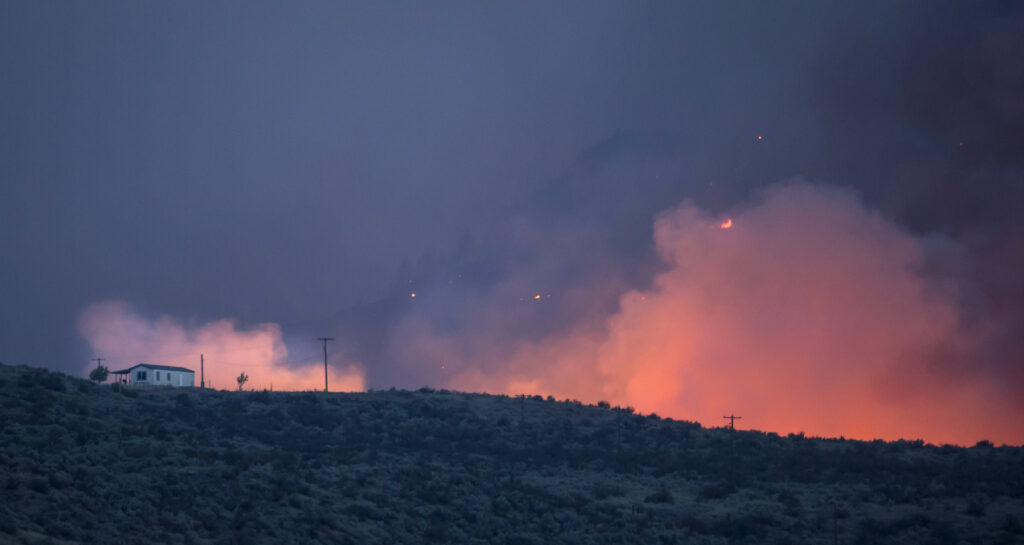Part of the Okanogan wildfire complex flares up on August 21, 2015 in the hills near Omak. The fires, which killed three firefighters and critically injured another, threatened homes and communities throughout the area. (Photo by Stephen Brashear/Getty Images)
The last time the state Building Code Council crafted rules for protecting homes from the threat of wildfire, city and county officials criticized them as confusing, expensive and overreaching.
Those rules are gone. As the state looks at drawing new wildfire risk maps and implementing new codes, local governments want more say in hopes of producing regulations that are understandable, affordable and help the communities most at risk.
“There should be opportunities for the public, subject matter experts and local jurisdictions to weigh in on this process,” said Brad Medrud, planning manager at the City of Tumwater. “It shouldn’t just be the county and [Department of Natural Resources] deciding what this should be moving forward.”
Lawmakers on the state House Local Government committee heard this week from officials of state agencies and local governments, including Medrud, about what must be done to implement new wildland urban interface, or WUI, building codes, and what a new law will mean for cities and counties.
A 2018 law directedI g the state Building Code Council to write new regulations requiring homes on the edge of wilderness be built with certain fire-resistant materials, less surrounding vegetation and more accessible driveways.
Under that law, the Department of Natural Resources was charged with mapping the state’s wildland urban interface. The final map required most of the state to follow at least some of the new code, sparking criticism from counties and cities that it overstates wildfire risks in some places and could make homes less affordable at a time when the state has a growing shortage.
Lawmakers passed a law this year requiring the department to draw a new map and limiting which parts of the code, already approved by the state Building Code Council, could go into effect. On the day that law went into effect, the council scrapped its new rules altogether.
Now, everyone is trying to figure out where to go from here.
New maps, more input
That new map is the main task. It must be based on wildfire risks across the state, keeping in mind terrain, climate and vegetation.
Loren Torgerson of the Department of Natural Resources told lawmakers Monday they are looking at using an existing risk assessment developed by the U.S. Forest Service as a foundation, although the exact criteria for at-risk communities is still being determined. DNR is on track to finalize the map elements by Dec. 1 and award a contract to create the map by March 1, 2025, Torgerson said.
Medrud urged the department to look at what other states have done to create their risk maps and to talk to local communities that may have a better idea of their risks.
“Tumwater is in no way similar to Richland,” he said.
Paul Jewell, at the Washington State Association of Counties, said many counties have risk maps that are likely much more accurate than a state-level map could be.
He urged state officials to talk with leaders in those communities about including some of their findings in the state map or allowing them to determine which codes make the most sense for their communities. For example, some counties already have stricter wildfire protection codes in place.
“Counties just need to know the rules and they need to understand them,” Jewell said.
‘Significant departure’ from other processes
Once the map is completed, the state will implement new codes. But under the law passed earlier this year only specific codes can go into effect, basically scrapping work the Building Code Council did in recent years to write new rules.
The council is trying to figure out where they fit into the new process.
On Monday, Todd Beyreuther, Building Code Council vice chair, reiterated the council’s criticism that the law takes away their authority and is a “significant departure” from the previous rulemaking processes for writing state building codes.
The way the law is written, the council can only adopt parts of the International WUI Code as is, or nothing at all, said Dustin Curb, managing director at the Building Code Council. And there’s no ability for the state council to amend those codes to meet Washington-specific needs.
“This dramatically reduces the ability of the state Building Code Council to enter the public process with subject matter experts to amend,” Beyreuther said.
Curb said lawmakers should consider passing a fix next session that adopts some portions of the codes but still gives the council some authority to amend them.
Jewell, however, said the current policy is the best one moving forward, given its flexibility for local governments.
The post Local governments want say in crafting new wildfire protection rules appeared first on Washington State Standard.

